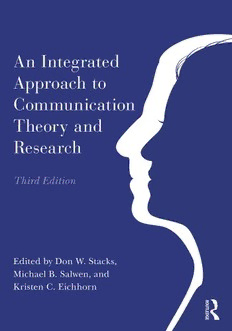
An Integrated Approach To Communication Theory And Research PDF
Preview An Integrated Approach To Communication Theory And Research
An Integrated Approach to Communication Theory and Research This new edition provides a comprehensive overview of current theory and research written by the top theorists and researchersin each area. It has been updated to address the growing influence of technol- ogy, changing relationships, and several growing integrated approaches to communication and includes sevennewchapterson: ■ DigitalMedia ■ MediaEffects ■ Privacy ■ DarkSide ■ AppliedCommunication ■ RelationalCommunication ■ InstructionalCommunication ■ CommunicationandtheLaw The book continues to be essential reading for students and faculty who want a thorough overview ofcontemporarycommunicationtheoryandresearch. Don W. Stacks, Ph.D., is Professor Emeritus of Corporate Communication and Public Relations in the School of Communicationat the University ofMiami, Coral Gables,FL. Heserved as program director from 1995 to 2009 when he took the program into the top 25 undergraduate and top 15 graduate public relations programs in the United States, with a focus on strategic communication and research. HeservedasAssociateDeanforResearchfrom2009to2011. Michael B. Salwen, Ph.D., Michigan State University, (1954–2007) was Professor of Journalism at the UniversityofMiami,SchoolofCommunication,FL. KristenC. Eichhorn, Ph.D.,isDeanoftheDivisionofGraduateStudiesandProfessor ofCommunica- tion Studies in the School of Communication, Media and the Arts at the State University of New York at Oswego. Dr. Eichhorn received a B.A. degree in Communication Studies and Spanish from Canisius College in Buffalo, NY (1999), an M.A. in Communication Research from West Virginia University (2000), and a Ph.D. in Communication Research at the University of Miami, FL (2003). More recently, she was a 2013 participant in the American Council in Education’s (ACE) RegionalWomen’s Leadership forumanda2016–2017ACEFellowatCornellUniversity,NY. Routledge Communication Series Jennings Bryant/Dolf Zillmann, Series Editors Selected titles include: Mass Communications Research Resources An Annotated Guide Edited by Christopher H. Sterling, James K. Bracken, and Susan B. Hill Perspectives on Radio and Television Telecommunication in the United States, 4th Edition F. Leslie Smith, David H. Ostroff, and John W. Wright Balancing the Secrets of Private Disclosures Edited by Sandra Petronio The Business of Sports Off the Field, in the Office, on the News, 3rd Edition Mark Conrad Advertising and Public Relations Law, 3rd Edition Carmen Maye, Roy L. Moore, and Erik L. Collins Applied Organizational Communication Theory and Practice in a Global Environment, 4th Edition Thomas E. Harris and Mark D. Nelson Public Relations and Social Theory Key Figures, Concepts and Developments, 2nd Edition Edited by Øyvind Ihlen and Magnus Fredriksson Advertising Theory, 2nd Edition Shelley Rodgers and Esther Thorson An Integrated Approach to Communication Theory and Research, 3rd Edition Edited by Don W. Stacks, Michael B. Salwen, and Kristen C. Eichhorn For a full list of titles please visit: https://www.routledge.com/Routledge-Communication- Series/book-series/RCS. An Integrated Approach to Communication Theory and Research Third Edition Edited by Don W. Stacks, Michael B. Salwen, and Kristen C. Eichhorn Thirdeditionpublished2019 byRoutledge 52VanderbiltAvenue,NewYork,NY10017 andbyRoutledge 2ParkSquare,MiltonPark,Abingdon,Oxon,OX144RN RoutledgeisanimprintoftheTaylor&FrancisGroup,aninformabusiness ©2019TaylorandFrancis TherightofDonW.Stacks,MichaelB.Salwen,andKristenC.Eichhorntobeidentified astheauthorsoftheeditorialmaterial,andoftheauthorsfortheirindividualchapters, hasbeenassertedinaccordancewithsections77and78oftheCopyright,Designsand PatentsAct1988. Allrightsreserved.Nopartofthisbookmaybereprintedorreproducedorutilisedin anyformorbyanyelectronic,mechanical,orothermeans,nowknownorhereafter invented,includingphotocopyingandrecording,orinanyinformationstorageor retrievalsystem,withoutpermissioninwritingfromthepublishers. Trademarknotice:Productorcorporatenamesmaybetrademarksorregistered trademarks,andareusedonlyforidentificationandexplanationwithoutintentto infringe. FirsteditionpublishedbyLEA1996 SecondeditionpublishedbyRoutledge2009 BritishLibraryCataloguing-in-PublicationData AcataloguerecordforthisbookisavailablefromtheBritishLibrary LibraryofCongressCataloging-in-PublicationData Acatalogrecordhasbeenrequestedforthisbook ISBN:978-1-138-56144-1(hbk) ISBN:978-1-138-56147-2(pbk) ISBN:978-0-203-71075-3(ebk) TypesetinMinionPro bySwales&Willis,Exeter,Devon,UK Contents Prefacetothe1996Edition.................................................................................................................ix Prefacetothe2007Edition...............................................................................................................xiii PrefacetotheThirdEdition................................................................................................................xv PARTONE:STUDYING“THEORY”:DOING“RESEARCH”.....................................................................1 CHAPTER1—IntegratingTheoryandResearch:StartingwithQuestions.........................................3 DonW.StacksandMichaelB.Salwen CHAPTER2—ThinkingaboutTheory...............................................................................................15 StevenH.Chaffee CHAPTER3—ThinkingQuantitatively..............................................................................................33 MichaelJ.Beatty CHAPTER4—TheQualitativeMethodinCommunicationResearch................................................43 MarkHicksonIIIandBrennanHickson PARTTWO:MASSCOMMUNICATION:APPROACHESANDCONCERNS.............................................57 CHAPTER5—MassCommunicationTheoryandResearch:TheDynamicNatureof TheoreticalApproaches.............................................................................................59 WayneWantaandBarbaraMyslik v vi Contents CHAPTER6—PrivacyIssuesinCommunication............................................................................73 FritzMessere CHAPTER7—MediaGatekeeping..................................................................................................87 TimP.Vos CHAPTER8—TheAgenda-SettingRoleoftheNewsMedia..........................................................99 SebastiánValenzuelaandMaxwellMcCombs CHAPTER9—CultivationAnalysis:ResearchandPractice..........................................................113 NancySignorielli,MichaelMorgan,andJamesShanahan CHAPTER10—TheoriesandMethodsinKnowledgeGapResearch.............................................127 CecilieGazianoandEmanuelGaziano CHAPTER11—UsesandGratifications..........................................................................................139 PaulHaridakisandZacharyHumphries CHAPTER12—SpiralofSilence.....................................................................................................155 CharlesT.SalmonandThanomwongPoorisat CHAPTER13—InternationalCommunication.................................................................................169 LinditaCamaj CHAPTER14—ViolenceandSexintheMedia...............................................................................185 WesFondren,KyleJ.Holody,andJenningsBryant CHAPTER15—Advertising.............................................................................................................199 EstherThorsonandShellyRodgers CHAPTER16—DigitalMedia:IdentityManagement......................................................................213 LeeHumphreys,AlexaPaley,andSierraRinaldi CHAPTER17—MediaEffects:AFunctionalPerspective................................................................223 NicholasDavidBowman PARTTHREE:HUMANCOMMUNICATIONAPPROACHESANDCONCERNS......................................235 CHAPTER18—HumanCommunicationTheoryandResearch:TraditionsandModels.................237 VirginiaP.RichmondandJamesC.McCroskey Contents vii CHAPTER19—TheRhetoricalPerspective:Doing,Being,Shaping,andSeeing...........................247 J.DavidCisneros,KristenL.McCauliff,andVanessaB.Beasley CHAPTER20—Persuasion..............................................................................................................261 MichaelD.MillerandTimothyR.Levine CHAPTER21—InterpersonalCommunication................................................................................277 CharlesR.BergerandMichaelE.Roloff CHAPTER22—DelineatingtheDarkSideofCommunication........................................................293 BrianSpitzberg CHAPTER23—InterculturalCommunication..................................................................................307 ThomasM.SteinfattandDianeM.Millette CHAPTER24—IntrapersonalCommunicationandImaginedInteractions: AMusicalApplication.............................................................................................321 JamesM.Honeycutt CHAPTER25—NonverbalCommunication.....................................................................................333 AmyS.EbesuHubbardandJudeeK.Burgoon CHAPTER26—AppliedCommunication.........................................................................................347 LawrenceR.FreyandJeanetteGerman CHAPTER27—OrganizationalCommunication:TheoryandPractice............................................359 JessicaWendorfMuhamad,TylerR.Harrison,andFanYang PARTFOUR:INTEGRATEDAPPROACHESTOCOMMUNICATION.....................................................375 CHAPTER28—RelationalCommunication.....................................................................................377 SeanM.HoranandLeahE.Bryant CHAPTER29—InternetCommunication(andSocialMedia)..........................................................387 MarcusMessner,BruceGarrison,andMarciaW.DiStaso CHAPTER30—CorporateCommunication.....................................................................................399 ShannonA.Bowen CHAPTER31—DiffusionofInnovations.........................................................................................415 EverettM.Rogers,ArvindSinghal,andMargaretM.Quinlan viii Contents CHAPTER32—Credibility...............................................................................................................435 CharlesC.SelfandChrisRoberts CHAPTER33—PoliticalCommunication........................................................................................447 SharonE.JarvisandKassieM.Barroquillo CHAPTER34—PublicRelationsandIntegratedCommunication...................................................463 DustinSupa CHAPTER35—HealthCommunication:SocialSupportandHealthOutcomes..............................479 KevinB.Wright CHAPTER36—FeministTheory.....................................................................................................493 CarolynGarrettCline CHAPTER37—CommunicationEthics...........................................................................................505 DonaldK.Wright CHAPTER38—InstructionalCommunication.................................................................................517 MarianL.Houser CHAPTER39—CommunicationandtheLaw.................................................................................529 JasonZenor PARTFIVE:FUTUREOFTHEORYANDRESEARCHINCOMMUNICATION.........................................543 CHAPTER40—TheFutureofCommunicationTheoryandResearch.............................................545 MichaelJ.BeattyandPaolaPascual-Ferrá ListofContributors...........................................................................................................................553 Index.................................................................................................................................................563 Preface to the 1996 Edition The Integrative Process This volume focuses on integrating theory and research in communication study. The terms “theory” and “research” are often linked together, like bread and butter, bagel and cream cheese, or speech communication and mass communication. It is stating the obvious to say that theory and research should be similarly linked together. Despite the obviousness of this statement, it comments on our field that a volume such as this that links communication theory and research in the same chapters is needed. Our purpose in editing this volume is to provide both seasoned scholars and beginning students unfamiliar with the state of theory and research in various areas of communication study a taste, a sampler if you will, of current theory and research in communication. To explicate the integration process, the chapter contributors, experts in their respective areas, offer sample studies in the form of hypothetical studies, published studies, or unpublished research, showing how theory and research are integrated in their particular areas. The idea for this book grew out of a series of informal discussions between the coeditors by the water cooler, in the photocopy room, in the hallway, by the coffee machine, and out- side faculty mailboxes. In these discussions, we complained about the difficulty of teaching communication students communication theory and research. As with many programs, theory and research are taught in the University of Miami’s School of Communication as separate courses. This clean curricular separation, however, bears no resemblance to how the courses are actually taught. Faculty who teach communication theory often digress into a discussion on research methods to make sense of exemplar studies. This is no small matter: sometimes an entire theory class is devoted to discussions of research methods. Like- wise, faculty who teach research methods have—out of necessity—had to bring discussion of theory into their courses. It was clear that the teachers were not to blame for this situation: the curriculum was at fault. In attempting to alleviate the problem of linking theory and ix
